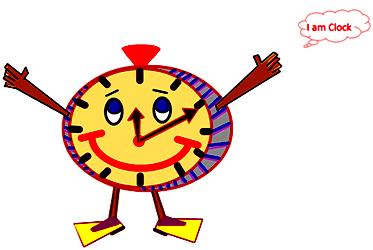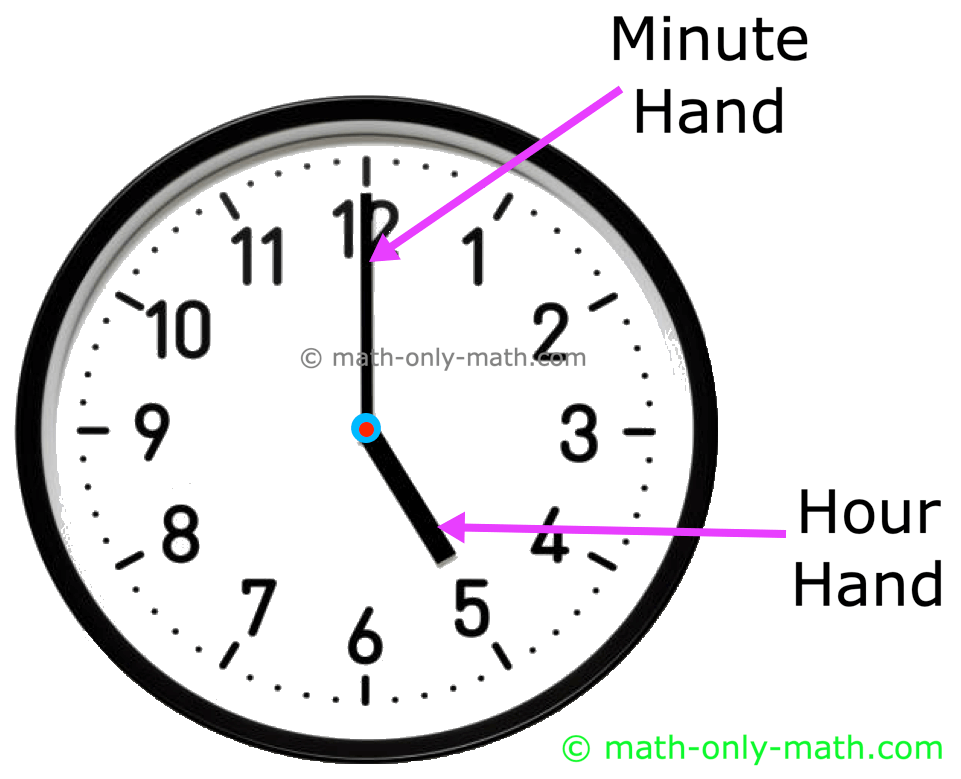Subscribe to our ▶️ YouTube channel 🔴 for the latest videos, updates, and tips.
Measurement of Time
We know that the measurement of time is read by a clock or a watch.
Any clock or watch except a digital watch, has a dial. On the circular border of the dial of a watch or clock there are the hour numbers from 1 to 12 at equal intervals. Between the two numbers there are five divisions. Each division represents a minute.
There are two hands of different lengths having one of the ends fixed at the center of the dial. The small hand is the hour hand and longer hand is the minute hand. The hour-hand moves slower than the minute hand. There is also a third hand called the second-hand. It moves very fast.
The hour hand makes one round of the dial in 12 hours. It moves from one number to its nearest number in one hour, i.e., the hour hand goes from 12 to 1 or 1 to 2 or 2 to 3, ........ etc., in one hour.
The minute hand makes one round of the dial in 1 hour. It moves across one division in one minute or five divisions in 5 minutes.
If there is a second-hand, it makes one round of the dial in one minute, i.e. it moves across one division in one second.
On this basis we say:
1 hour = 60 minutes or 60 minutes = 1 hour
1 minute = 60 seconds or 60 seconds = 1 minute
1 hour = 60 minutes = 60 × 60 or 3600 seconds
We know that the face of the clock is marked with the numbers from 1 to 12, which divide the clock face into 12 equal parts. These 12 parts are further divided into 60 small divisions. So, there are 5 small divisions between any two numbers on the clock face. The minute hand takes 5 minutes to move from one number to the next number. We have learnt how to read the time correct to 5 minutes.
We see the time by a watch or a clock.
The long hand is the minute hand.
The short hand is the hour hand.
Look at the clock.
The long hand is at 12.
The short hand is at 5.
The time is 5 o'clock.
We read 5 o'clock as five o'clock.
We write 5 o'clock as 5:00.
Remember
o'clock means 'of the clock.
SUMMARY:
🟢 When time is in half hours, the minute hand is at 6.
🟢 When the minute hand is at 3, the time is read as 'Quarter past
🟢 When the minute hand is at 9, the time is read as 'Quarter to
🟢 The time between midnight and noon is written as am. (ante meridiem)
🟢 The time between noon and midnight is written as pm. (post meridiem)
🟢 A calendar shows days, weeks and months of a year.
🟢 A year has 12 months.
🟢 A week has 7 days.
Worksheet on Measurement of Time:
I. Multiple Choice Questions (MCQ) on Third Grade Money:
Tick (✔) the correct option.
1. How many hours are there from 12 noon to 12 midnight?
(a) 10; (b) 12; (c) 24
2. 10 minutes past 11 is same as:
(a) 10 minutes to 11; (b) 11:10; (c) 10:11
3. 3 hours and 35 minutes = _____ minutes.
(a) 215; (b) 210; (c) 225
4. Time taken to eat lunch:
(a) 20 minutes; (b) 10 hours; (c) 2 hours
Answer:
I. 1. → (b) 12
2. → (b) 11:10
3. → (a) 215
4. → (a) 20 minutes
Related Concepts
● To Measure the Length of a Line-segment
● Examples on Unit of Mass or Weight
● Units for The Measurement of Capacity
● Examples on Measurement of Capacity
● Antemeridian (a.m.) or Postmeridian (p.m.)
● Calendar
● Reading and Interpreting a Calendar
From Measurement of Time to HOME PAGE
Didn't find what you were looking for? Or want to know more information about Math Only Math. Use this Google Search to find what you need.




New! Comments
Have your say about what you just read! Leave me a comment in the box below. Ask a Question or Answer a Question.